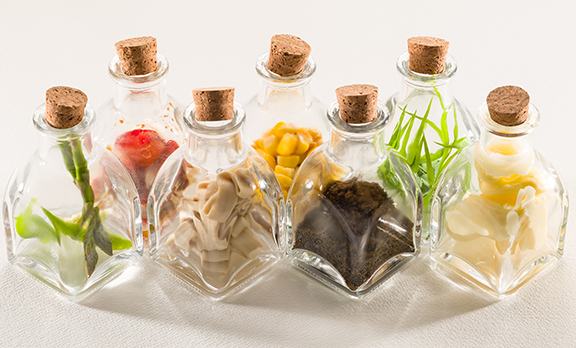
It’s as much a process as it is a condition. It’s also a perfectly natural part of the fermenting process. It can happen at any time and depending on when and how it does, it can ruin your wine. It’s volatile acidity (VA) and it’s basically the process of wine turning into vinegar. For home winemakers, it’s a common problem.
“Among home wine producers it’s very common,” said Dr. Linda Bisson, professor of enology at the University of California, Davis. According to Dave Lustig, a home winemaker since 1991 who teaches wine judging clinics for The Cellarmasters home winemaking club in Los Angeles, California, volatile acidity is one of the most common faults in home-made wine.
Then again, to some consumers, it can be just another layer of flavor.
“It’s one of those things that still falls into that range of taste,” said Lustig, who recently went professional with his partners, forming the 4 Joes label. “Where maybe the winemaker at the judging table tastes it and says, ‘Whew, that’s got VA,’ the consumer may say, ‘there’s something interesting going on there.’”
“Part of it is a threshold thing,” said Penelope Gadd-Coster, associate winemaker at J Vineyards and Winery in Sonoma, California. After years of home winemaking, as well, Gadd-Coster has just gone commercial with her own label, Coral Mustang. “If you look at the old, old Italian wines of the past, they all have VA issues. They were just part of the character.”
Volatile acidity is mostly caused by bacteria in the wine creating acetic acid — the acid that gives vinegar its characteristic flavor and aroma — and its byproduct ethyl acetate. But there are a few rogue yeasts that can do the same thing. The catch is that you can’t escape the “bugs.”
“It’s pretty much everywhere,” Gadd-Coster said. “It can come in on your fruit, it can be on your equipment. Fruit flies are full of it.”
If you have a nick in the bottom of your glass carboy or a scratch in your plastic fermentation bucket, it can harbor the bugs that cause volatile acidity. Barrels, in particular, unless they have been thoroughly cleaned and disinfected, can have all kinds of volatile acidity-causing bugs in them. In fact, there will always be something in your wine that has the potential to create volatile acidity. But the bugs also need one other thing to trigger the reaction — air.
“What you have to control is the oxygen,” Bisson said.
She said that one of the reasons home winemakers tend to have such a big problem with volatile acidity is the situation where the winemaker has just enough wine to fill a container, be it a 50-gallon (189-L) barrel or 5-gallon (19-L) carboy. As the level of the wine drops through racking, tasting and general evaporation, air is introduced into the container and the microbes come to party.
Temperature is also an issue. “They prefer to be warm and have lots of air,” Gadd-Coster said.
Bisson agreed with Gadd-Coster, saying, “The bacteria like it hot. There are times when people use warming blankets to get the yeast to finish. You have to be careful of that because the bacteria are happy that way.”
In short, volatile acidity can occur anytime you have the appropriate microbes, oxygen from air and a sufficient amount of heat. As such, volatile acidity can appear at any point in the wine process. You can get it during primary fermentation. You can get it during malolactic fementation.
“The worst case is when you open a bottle and it’s there and it wasn’t there when you bottled it,” Lustig said.
The most obvious sign of volatile acidity is the smell, which actually gets a little complicated because it’s not just one smell.
“The acetic acid, it’s more of a pungency,” said Bisson, “so it doesn’t have an easily recognized smell.”
You’re more likely to pick up the scent of the ethyl acetate — which smells like glue or nail polish remover. Although, if you catch the volatile acidity in its earliest stages, you may only taste the ethyl-acetate on the back of your palate.
If you’re using glass carboys, another early sign is a brittle film on the top of your wine. Later, assuming the bug you’re dealing with is an actual aceto-bacter, the film will become a white, ropy layer, and by then, you are definitely stuck with salad dressing.
When you see these signs, “You’ve gone way, way over the edge,” Coster said. Like most things in winemaking, prevention starts with your fruit. Because the bugs can come in with the fruit, Gadd-Coster suggested washing your grapes before crushing. But Bisson suggets that this isn’t usually necessary. It’s more important to make sure you have healthy fruit.
“It can come in on grapes if the grapes have sour rot,” Bisson said, explaining that if you can manage, it doesn’t hurt to go through all your grapes if you haven’t picked them yourself.
Some grape producers will hide less than perfect grapes under a layer of good fruit, covering potential problems for the home winemaker.
“You want to be sure you can sort through what they’re giving you,” she said. Make sure you taste the grapes, too. “It’s fairly obvious if you’ve got sour rot. If it’s going into the wine, pop it in your mouth.”
Because fruit flies are often the source of bad bacteria, it doesn’t hurt to set out traps or fly strips around your fermenting area, as well.
“They’re a problem because they carry all sorts of crap with them when they come in,” Bisson said. “A lot of the bad lactic acids reside in their guts, too. We’ve had wine spoil with just one body.” In fact, she recounted a time when she and her students found a single fly floating in their fermenter with the tell-tale signs surrounding it.
“You could see the growth starting,” she said.
Lustig said that he’s only had problems with volatile acidity a couple times and when asked why, he said simply, “Cleanliness.”
Gadd-Coster said that just keeping things clean can go a long way to making sure the bugs don’t get the upper hand. Clean and spray your hopper before crushing, the same with your press. When you’re opening your containers for testing, you can spray the lips with liquid sulfur dioxide (SO2).
“But you have to be really careful because you can over SO2,” she said. “Make sure it’s a really light spritz. The other thing that you can do, you can take vodka and you can spray that on the top. Don’t mix it in. Regularly spray down your bungs.”
Gadd-Coster said that she prefers vodka for such spraying because it smells better.
But speaking of SO2, keeping those levels up can also deter VA. Gadd-Coster, who recommends keeping it between 30 and 35 ppm.
“I like to go as low as I possibly can,” she said.
But if you’ve got a lot of raisins or other problems with your fruit, she said you might want to go as high as 50 ppm.
Bisson cautioned that while SO2 is critical to controlling the bugs that cause volatile acidity, it’s no guarantee.
“Some of them [the bugs], while they’re sensitive to SO2, it won’t kill,” she said. “If they float to the top, and there’s air there, then they can just take off on the surface.”
Which is why topping off is such a critical issue. If air is what triggers the reaction, then you want as little air in your containers as possible. Gadd-Coster said that she likes to keep her carboys with just a hairline of space to allow for expansion, but that means keeping a close eye on the wine.
While you can use water to top off, it can create problems with diluting the flavor, aromas and alcohol levels in the wine. But Gadd-Coster says that’s not the only reason you probably want to avoid it.
“You don’t know what’s in your water, too,” she said. “You could have little critters in your water. They may not be that active in the water. But once you’ve introduced them into the wine media, they go whoo-hoo!”
Another trick that Gadd-Coster said she’s heard of is displacing the missing wine with small rocks or marbles that have been cleaned and sanitized.
“As you’re losing wine, you can put a few more marbles in and bring up your level,” she said. “Anything like that will bring the level back and that keeps your VA down.”
This may be just the trick needed for the home winemaker who doesn’t have an endless variety of containers in smaller and smaller sizes to rack into.
Observation is also key, especially when the process isn’t going as smoothly as usual. Bisson said that if you get a slow fermentation and you’re waiting for your yeast to take out that last remaining bit of sugar, that’s a perfect time for volatile acidity to form.
Another risky time is any time you open your containers, Gadd-Coster pointed out.
“Every time you open that bung, you’re introducing bugs,” she said.
If the conditions are right, volatile acidity can develop in less than a day.
“If it’s going to go in, it’s going to be really quick,” Gadd-Coster said. “Things can turn practically overnight. You don’t want to open [your container] up every single day, but at least look at it, make sure it looks clean.”
The problem with volatile acidity is that once you’ve got it, there’s not a lot you can do to get rid of it. But, as Bisson pointed out, one of the advantages of being a home winemaker is that you can experiment and see what happens.
If volatile acidity shows up during primary fermentation, Lustig said that often the process of pressing and racking the wine will be enough to get rid of it. Make sure your SO2 levels are up and proceed as usual.
After that, Bisson said that you can get rid of it with a process call reverse osmosis, but that is so expensive that it is not practical for the average home winemaker. You can also lose some of the wine’s character that way.
“What most of the big guys do is get rid of it by dilution,” she said, “but you have to have enough wine that you can blend it.”
If you’re seeing just a little bit of film, you can try to introduce a tube into the wine, pour in more wine to spill the contaminated top layer out of the container. You could also try removing the film with paper towels.
“And check the wine underneath,” Gadd-Coster said. “Sometimes I’ll smell it just on the top, but the wine underneath is still fine.”
She also said that sometimes you can filter out the bugs, using very fine filters, down to 0.8 to 0.45 microns thick.
“You probably wouldn’t find a coffee filter that would go down that low,” she said. “It would be something that you’d want to be food grade. Some of the beverage stores are carrying the smaller ones, some of the pad filters down to a 0.6 [micron]. You hope that you catch it before it gets too high, then you’re eliminating the crittters that are causing it.”
Bisson said that masking the flavor of the volatile acidity is a popular tactic.
“Some people have had success by burying it in oak,” she said. Others try using fruit juice, “but you have to be careful because you might be giving [the bugs] more nutrients.”
“When you get it bad, the only thing you can do is blend it out,” Lustig said, “but that brings up the question, how much bad wine are you willing to waste your good wine on?”
The key, he said, is not to just give up. “It’s always worth trials before you decide to dump it. And, of course, you have to dial up your SO2.” And Bisson conceded that if worse comes to worse, you can keep fermenting your VA-laden wine until it’s balsamic vinegar.
“Which wouldn’t be bad,” she said, laughing. “You bottle it in fancy little bottles and tell people that’s what you meant to make.”







